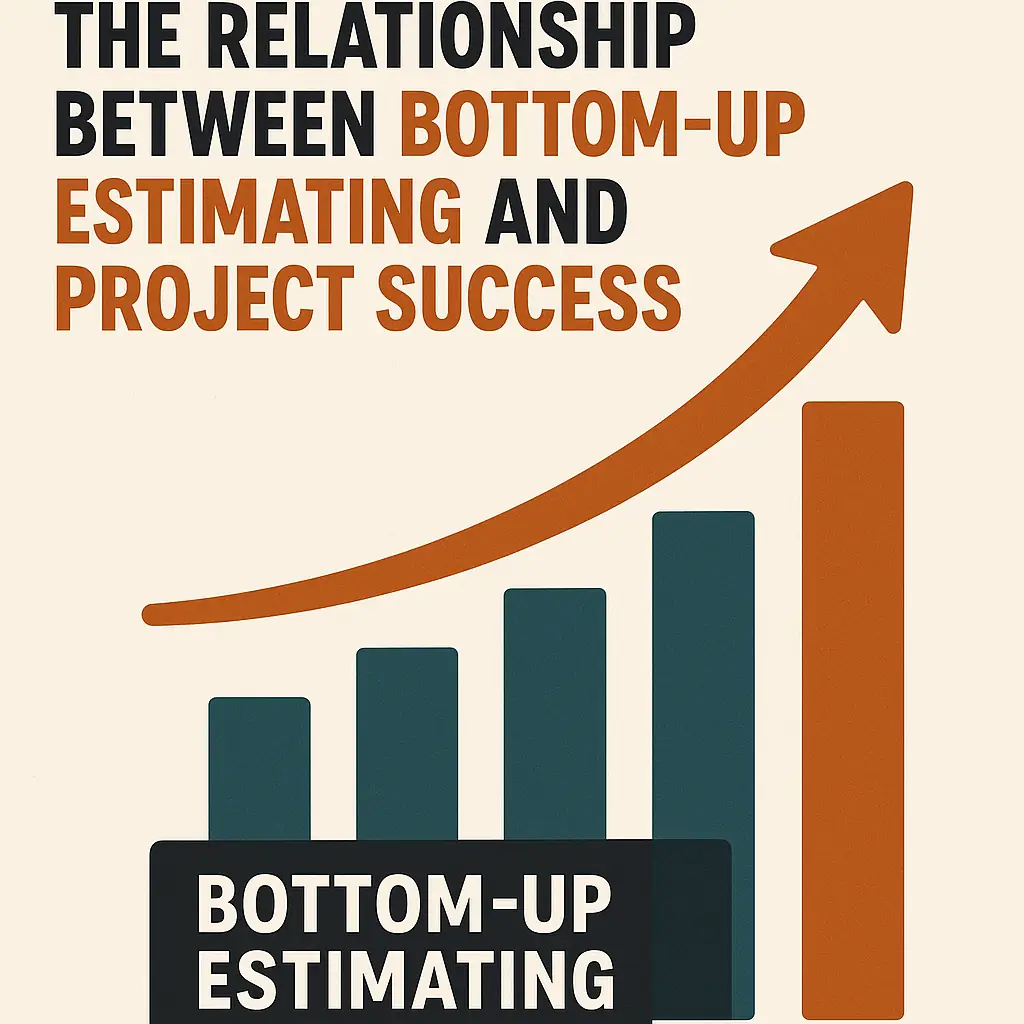Introduction
The accuracy of estimates plays a pivotal role in determining the success of any project. One of the most effective techniques for achieving precise estimates is bottom-up estimating. This method involves breaking down a project into its smallest components, allowing project managers to assess the time, cost, and resources required for each individual task. By aggregating these granular estimates, a comprehensive overview of the project’s total requirements is established, which significantly enhances the accuracy of the overall project estimate [10][14].
The relationship between accurate estimates and project success cannot be overstated. Research indicates that projects with well-defined and precise estimates are more likely to meet their objectives, stay within budget, and adhere to timelines. This correlation is particularly crucial for project executives and managers, who are tasked with ensuring that projects are delivered successfully while optimizing resource allocation and minimizing risks. By employing bottom-up estimating, these leaders can gain a clearer understanding of the project’s scope and potential challenges, ultimately leading to better decision-making and project outcomes [3][12][13].
As we delve deeper into the significance of bottom-up estimating, it is essential to recognize its value not only in enhancing accuracy but also in fostering a culture of accountability and collaboration among team members. This approach empowers project teams to take ownership of their tasks, leading to improved performance and a higher likelihood of project success. In the following sections, we will explore the methodologies, benefits, and best practices associated with bottom-up estimating, providing project executives and managers with the insights needed to leverage this technique effectively in their projects.
Understanding Bottom-Up Estimating
Bottom-up estimating is a crucial technique in project management that focuses on creating accurate project estimates by evaluating individual tasks or components in detail. This method is particularly beneficial for project executives and managers who seek to enhance project outcomes through precise planning and resource allocation.
The Bottom-Up Estimating Process
The bottom-up estimating process begins with a granular analysis of the project. Here are the key steps involved:
- Task Breakdown: The project is divided into smaller, manageable units of work, often referred to as work packages. This breakdown allows for a more detailed examination of each component, ensuring that no aspect of the project is overlooked [11][14].
- Cost and Time Estimation: For each task, project managers estimate the required time, costs, and resources. This detailed approach enables a comprehensive understanding of what each task entails, leading to more accurate overall project estimates [8][10].
- Aggregation of Estimates: Once all individual estimates are completed, they are aggregated to form a total estimate for the project. This upward aggregation ensures that the final estimate reflects the cumulative insights gained from the detailed analysis of each task [11].
Importance of Detailed Resource Allocation and Time Estimation
Accurate estimates derived from the bottom-up approach significantly enhance resource allocation and time management. The benefits include:
- Improved Accuracy: Bottom-up estimating is known for its high accuracy, as it relies on detailed assessments rather than broad assumptions. This precision helps in creating realistic project plans and budgets, which are essential for minimizing risks and increasing the likelihood of project success [1][15].
- Enhanced Resource Management: By understanding the specific needs of each task, project managers can allocate resources more effectively. This targeted allocation helps in avoiding overallocation or underutilization of resources, which can derail project timelines and budgets [15].
- Risk Mitigation: Detailed estimates allow for better risk management. By identifying potential challenges at the task level, project managers can develop strategies to address these issues before they escalate, thereby safeguarding project outcomes [5][15].
Contrasting Bottom-Up Estimating with Other Estimation Methods
While bottom-up estimating is highly regarded for its accuracy, it is essential to contrast it with other estimation methods to understand its unique advantages:
- Top-Down Estimating: This method involves estimating the overall project cost and duration based on historical data or expert judgment. While it is quicker and less resource-intensive, it often lacks the detail necessary for accurate planning, making it less reliable for complex projects [2][12].
- Parametric Estimating: This technique uses statistical relationships between historical data and other variables to estimate project costs and durations. Although it can provide quick estimates, it may not account for the specific nuances of a new project, leading to potential inaccuracies [2][12].
The Importance of Accurate Estimates
Accurate estimates in project management are fundamental to achieving successful project outcomes. They serve as the backbone for budgeting, scheduling, and resource management, directly influencing the overall health of a project. Here are some key points that highlight the significance of accurate estimates:
- Impact on Budgeting: Accurate estimates allow project managers to allocate financial resources effectively. When estimates are precise, it minimizes the risk of budget overruns, which can lead to project delays or even cancellations. Bottom-up estimating, which involves breaking down the project into smaller components and estimating costs for each, provides a detailed view of the financial requirements, ensuring that all aspects of the project are accounted for [12][14].
- Scheduling Efficiency: Accurate estimates are crucial for developing realistic project timelines. They help in identifying the time required for each task, which is essential for creating a comprehensive project schedule. When estimates are based on detailed analysis, it reduces the likelihood of scheduling conflicts and ensures that project milestones are met on time [11][13].
- Resource Management: Effective resource allocation is heavily reliant on accurate estimates. By understanding the specific needs of each component of the project, managers can ensure that the right resources are available at the right time. This not only enhances productivity but also prevents resource wastage, which can occur when estimates are inaccurate [9][10].
- Risks of Inaccurate Estimates: Inaccurate estimates can lead to significant risks, including project overruns, which occur when the actual costs exceed the budgeted amounts. This can result in stakeholder dissatisfaction, as clients and team members may feel frustrated by delays and unexpected expenses. Moreover, inaccurate estimates can damage the credibility of project managers and the organization as a whole, leading to a loss of trust and future business opportunities [1][3].
- Statistics and Case Studies: Research indicates that projects with accurate estimates are more likely to succeed. For instance, a study found that projects utilizing bottom-up estimating techniques reported a 20% higher success rate compared to those relying on top-down estimates. Additionally, case studies have shown that organizations that prioritize accurate estimating practices experience fewer project overruns and higher stakeholder satisfaction rates. These findings underscore the critical role that accurate estimates play in achieving project success [2][12].
The Link Between Bottom-Up Estimating and Project Success
The accuracy of estimates plays a pivotal role in determining the success of a project. Bottom-up estimating, a method that involves breaking down a project into its smallest components to assess the time and cost required for each task, has emerged as a critical technique that aligns closely with key factors contributing to project success. This section explores the correlation between bottom-up estimating and overall project outcomes, emphasizing the importance of team involvement and expertise.
Key Factors Contributing to Project Success
- Effective Communication: Bottom-up estimating fosters open communication among team members. By involving the entire project team in the estimation process, it encourages dialogue about task requirements, potential risks, and resource allocation. This collaborative approach ensures that all voices are heard, leading to more accurate estimates and a shared understanding of project goals [6].
- Thorough Planning: The detailed nature of bottom-up estimating allows for comprehensive planning. Each component is estimated individually, considering factors such as materials, labor, equipment, and time. This meticulous breakdown not only enhances the accuracy of the estimates but also helps in identifying potential blockers and contingencies early in the project lifecycle [12][14].
- Strong Leadership and Stakeholder Engagement: Successful projects often have strong leadership that supports the bottom-up approach. Leaders who encourage team involvement in the estimation process can foster a sense of ownership and accountability among team members, which is crucial for stakeholder engagement and project buy-in [6][7].
- Continuous Monitoring and Adaptation: Bottom-up estimating facilitates ongoing monitoring of project progress. As estimates are based on detailed task breakdowns, project managers can more easily track performance against these estimates, allowing for timely adjustments and adaptations as needed [6][7].
The Role of Team Involvement and Expertise
The accuracy of bottom-up estimates is significantly influenced by the involvement and expertise of the project team. When team members who are directly responsible for specific tasks contribute to the estimation process, the estimates tend to be more realistic and grounded in practical experience. This participatory approach not only enhances the quality of the estimates but also boosts team morale and commitment to the project [15].
Moreover, the collective expertise of the team can uncover insights that a top-down approach might overlook. For instance, team members may identify unique challenges or resource needs specific to their tasks, leading to more informed and precise estimates. This collaborative effort ultimately contributes to a more robust project plan and increases the likelihood of successful outcomes [5][15].
Examples of Successful Projects Utilizing Bottom-Up Estimating
Several successful projects have effectively employed bottom-up estimating to achieve their objectives:
- Construction Projects: In large-scale construction projects, such as the development of infrastructure, bottom-up estimating has been instrumental. By breaking down the project into individual tasks like site preparation, foundation work, and utility installation, project managers can create detailed timelines and budgets that reflect the realities of the work involved. This approach has led to successful project completions within budget and on schedule.
- Software Development: In the tech industry, software development projects often utilize bottom-up estimating to gauge the time and resources needed for coding, testing, and deployment. By involving developers in the estimation process, companies can better anticipate challenges and allocate resources effectively, resulting in successful software launches that meet user expectations.
- Event Planning: Event management projects benefit from bottom-up estimating by allowing planners to assess the costs and logistics of each component, such as venue selection, catering, and entertainment. This detailed approach ensures that all aspects of the event are accounted for, leading to successful and memorable experiences for attendees.
Challenges and Limitations of Bottom-Up Estimating
Bottom-up estimating is a widely recognized technique in project management that involves breaking down a project into smaller, manageable components to provide detailed estimates of costs and durations. While this method can lead to highly accurate estimates and improved project outcomes, it is not without its challenges and limitations. Understanding these obstacles is crucial for project executives and managers aiming to leverage bottom-up estimating effectively.
Common Obstacles
- Time Consumption: One of the most significant challenges of bottom-up estimating is the time it requires. The process involves a thorough breakdown of all project tasks, which can be labor-intensive and may lead to delays in project initiation. Team members must invest considerable effort to analyze each component, which can be costly in terms of both time and resources [5][10].
- Complexity: The detailed nature of bottom-up estimating can introduce complexity into the project planning process. As projects grow in size and scope, the number of tasks and components to estimate can become overwhelming. This complexity can lead to potential errors or oversights, increasing the risk of serious inaccuracies in the final estimates [8][11].
- Increased Risk of Errors: The granular approach of bottom-up estimating can raise the likelihood of missing or misconstruing critical elements of the project. If team members overlook a task or misjudge the time required for a specific activity, it can result in significant discrepancies between estimated and actual project performance [8][9].
Scenarios Where Bottom-Up Estimating May Not Be Feasible
- Small Projects: For smaller projects with limited scope, the effort required for bottom-up estimating may outweigh the benefits. In such cases, simpler estimation techniques may be more appropriate, allowing for quicker project initiation without sacrificing accuracy [5][12].
- Rapidly Changing Environments: In dynamic project environments where requirements frequently change, the detailed nature of bottom-up estimating may become impractical. The time spent on creating detailed estimates could be wasted if project parameters shift significantly before execution [6][11].
- Resource Constraints: When teams are operating under tight deadlines or limited resources, the comprehensive analysis required for bottom-up estimating may not be feasible. In these situations, project managers may need to rely on alternative estimation methods that require less time and effort [5][10].
Solutions and Best Practices
- Utilize Software Tools: Implementing project management software can streamline the bottom-up estimating process. These tools can automate calculations and provide templates for task breakdowns, reducing the time and complexity involved in manual estimations [12].
- Involve Team Members Early: Engaging team members in the estimation process from the outset can enhance accuracy and buy-in. By leveraging their expertise and insights, project managers can ensure that all relevant factors are considered, minimizing the risk of errors [6][10].
- Adopt a Hybrid Approach: In scenarios where bottom-up estimating may not be feasible, consider a hybrid approach that combines elements of both bottom-up and top-down estimating. This can provide a balance between accuracy and efficiency, allowing for quicker project initiation while still maintaining a level of detail [12][15].
- Regularly Review and Adjust Estimates: Establishing a routine for reviewing and adjusting estimates throughout the project lifecycle can help mitigate the risks associated with inaccuracies. By continuously monitoring project progress and making necessary adjustments, project managers can better align estimates with actual performance [6][11].
Best Practices for Implementing Bottom-Up Estimating
Bottom-up estimating is a critical technique in project management that can significantly influence project success. By breaking down projects into smaller, manageable components and estimating costs and durations for each, project managers can achieve a higher level of accuracy in their estimates. Here are some best practices to enhance the bottom-up estimating process:
1. Utilize Tools and Software
To streamline the bottom-up estimating process, project managers should consider leveraging specialized tools and software. These can help in:
- Project Management Software: Tools like Microsoft Project, Asana, or Trello can assist in organizing tasks and tracking progress, making it easier to estimate time and resources accurately.
- Cost Estimation Software: Programs such as Primavera P6 or CostOS can provide detailed cost breakdowns and help in aggregating estimates from various components.
- Collaboration Tools: Platforms like Slack or Microsoft Teams can facilitate communication among team members, ensuring that everyone is aligned and informed during the estimating process.
By integrating these tools, project managers can enhance the accuracy and efficiency of their bottom-up estimates, leading to better project outcomes [4][10].
2. Encourage Regular Training and Skill Development
Investing in the continuous training and development of team members involved in estimating is essential. This can include:
- Workshops and Seminars: Regular training sessions can help team members stay updated on the latest estimating techniques and best practices.
- Mentorship Programs: Pairing less experienced team members with seasoned professionals can foster knowledge transfer and improve estimating skills.
- Certification Courses: Encouraging team members to pursue certifications in project management or cost estimation can enhance their expertise and confidence in the estimating process.
By prioritizing skill development, project managers can ensure that their teams are well-equipped to provide accurate estimates, ultimately contributing to project success [1][6].
3. Advocate for Stakeholder Engagement and Continuous Feedback
Engaging stakeholders throughout the estimating process is crucial for accuracy and buy-in. This can be achieved by:
- Involving Stakeholders Early: Including key stakeholders in the initial stages of the estimating process can provide valuable insights and help identify potential risks or challenges.
- Regular Check-Ins: Establishing a routine for feedback sessions can ensure that estimates are continuously refined based on stakeholder input and changing project dynamics.
- Transparent Communication: Maintaining open lines of communication with stakeholders fosters trust and encourages collaboration, which can lead to more accurate estimates.
By actively involving stakeholders and seeking their feedback, project managers can enhance the reliability of their bottom-up estimates, leading to improved project outcomes [2][3][5].
Conclusion
The accuracy of estimates plays a pivotal role in determining the success of a project. Bottom-up estimating, a method that involves breaking down projects into smaller, manageable components, has been shown to provide a more realistic and detailed view of project costs and timelines. This granular approach allows project managers to assess each task’s requirements accurately, leading to a comprehensive estimate that reflects the true scope of the project.
Key points to consider include:
- Correlation Between Accurate Estimates and Project Success: Numerous studies and practical applications have demonstrated that projects with precise estimates are more likely to meet their objectives, stay within budget, and adhere to timelines. By utilizing bottom-up estimating, project managers can significantly reduce the risks associated with inaccurate forecasting, thereby enhancing the likelihood of project success [3][4][8].
- Encouragement for Adoption: Project executives and managers are encouraged to embrace bottom-up estimating as a standard practice. This method not only fosters a culture of transparency and accountability but also empowers teams to engage in detailed planning and resource allocation. The accuracy gained from this approach can lead to improved decision-making and ultimately, better project outcomes [6][10][14].
- Reflection on Current Practices: It is essential for project leaders to evaluate their existing estimating practices critically. Are they relying on top-down estimates that may overlook critical details? Are they using templates that do not account for the unique aspects of their projects? By reflecting on these questions and seeking improvements, project managers can enhance their estimating processes, leading to more successful project executions [11][12][15].
In summary, the relationship between bottom-up estimating and project success is clear. By adopting this method, project managers can achieve greater accuracy in their estimates, which is crucial for navigating the complexities of modern projects. As the landscape of project management continues to evolve, embracing effective estimating techniques will be key to driving successful outcomes.
Find out more about Shaun Stoltz https://www.shaunstoltz.com/about/.
This post was written by an AI and reviewed/edited by a human.



